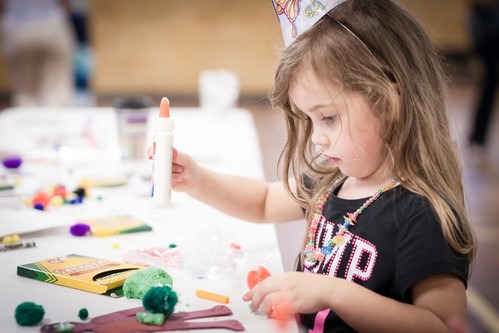Going Old School: Low-Tech Activities for Children

National guidelines recommend that children over the age of 2 should spend no more than two hours a day in front of a screen while children under 2 shouldn’t have any screen time. However, American children spend an average of seven hours a day in front of a screen — TV occupies three of those hours. This is concerning since medical professionals have found that increased screen time can lead to ADHD, poor sleeping patterns, obesity and/ or other psychiatric disorders in children. While many point to the need for children to be technologically savvy, parents need to find a balance between low tech and high tech learning in order to help their children fully develop.
Promote Creativity & Higher Level Thinking
Many early learning centers utilize sand and water tables with objects such as pinecones, seashells and more in order to promote active learning through play, which is also a hallmark of Montessori and High/Scope. Centers also encourage development in younger children by providing them with paintbrushes and water to allow them to “paint” on windows and bricks; they also give their young children baskets of “loose parts” (napkin rings, bottle caps, fabric, corks, etc.) for play. Loose-parts activities, which are teacher guided lessons, are a low-tech method that allow children to develop creativity and higher level thinking on their own terms.
Build Hand-Eye Coordination
While any parent who wishes to do so can implement the aforementioned techniques, there are many other low tech options to consider – many of which you may already have in your home. For instance, supervised use of blowguns, airsoft devices and slingshots are, believe it or not, great ways to teach children responsibility while improving their hand/eye coordination, another very important piece to a child’s development. This outdoor activity also helps with parent/child bonding as the parent will be there to teach and guide their child. Remember: these items can be deadly and should not be treated as toys. Only children who are mature enough to understand the dangers should be allowed to use the items and they must be supervised by an adult at all times.
Push Social & Emotional Development
Playdough is another beneficial low tech solution that keeps kids away from screens and the National Association for the Education of Young Children (NAEYC), which is the authority on early education in America, cannot say enough good things about its benefits. According to the NAEYC, playdough promotes social and emotional development, language and literacy, physical development, math and science, as well as creativity. Parents can boost playdough’s benefits by “cooking” homemade playdough with their children. It’s a money-saver that teaches children measurements and how to cook. Martha Stewart has an easy to follow playdough recipe on her website.
From slingshots to playdough to sand tables and loose parts activities, there are numerous ways to engage children without the use of technology. Limiting screentime and going old school will not only benefit your child, but will provide parents with more opportunities to interact with their children in a meaningful manner. Stepping away from the screen is a win-win situation for everyone involved.
What's Your Reaction?
Newly middle-aged wife of 1, Mom of 3, Grandma of 2. A professional blogger who has lived in 3 places since losing her home to a house fire in October 2018 with her husband. Becky appreciates being self-employed which has allowed her to work from 'anywhere'. Life is better when you can laugh. As you can tell by her Facebook page where she keeps the humor memes going daily. Becky looks forward to the upcoming new year. It will be fun to see what 2020 holds.



